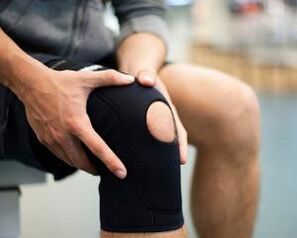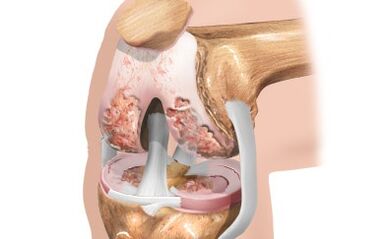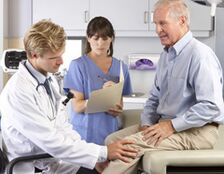Deforming the arthrosis of the knee joint is a polyethological disease. This means that there are great reasons for its development. In some cases, when the most dominant cause can be assigned, gonartrosis is called secondary. In the event that a clear cause is not determined, the diagnosis of the primary Ildiopathic arthrosis of the knee joint was established.

- Deforming osteoarthrosis of the medial part of the wake-up joint;
- Deformation of osteoarthrosis of the side part of the wake-wake hole;
- Deformation of arthrosis of the thigh of the delicious wrist.
Normally, the destruction of the articulated cartilage occurs in the process of physiological game of the whole organism, ie during aging. Pathological destruction of cartilage is considered when it appears before time or more intense tempo. The average age, on which on a fully legitimate basis, the first signs of cartilage degeneration can be manifested, a period of 40 to 50 years. With deformation of arthrosis, childhood debut disease with the first events of 16-18 years, and in some cases even earlier. However, this is not a reason for despair.
The disease development mechanism is a vicious circle in which the final links run the initial and so on in infinity. However, each round of this circle deteriorates the state of cartilage and leads to the disease promotion and so on the chain. In case of primary gonartrosis, the reason that runs a vicious circuit is not known. However, its subsequent connections are carefully studied with the aim of influencing them and slowing the disease progress.
Deforming arthrosis is developing approximately as follows. The daily joint cartilage of the knee joint has thousands of shocks that are forced to deprecate so that it would not harm more gentle structures of the human body, such as internal organs and brains. Over time, due to data on needs, microscopic cracks are formed in a cloudy layer, which are also filled with synovial fluid and turn into microdists after a certain time. Neighboring microdists tend to unite and form larger cysts.
Increasing the size of the pure space of the cornea gradually starts to squeeze the capillaries of blood that feed the cartilage from the side of the bone. The supply of oxygen and substances needed to maintain vital activity, worsens, leading to a range of 2 collagen synthesis.
Transport of cartilage leads to two negative consequences. First, leading to deterioration in depreciation properties and more intensive formation of new microcracks in the subsidiary. Second, due to the cartilage compression, its density increases, which negatively affects the second mechanism of its diet - through the diffusion of the Sinovian liquid in the tissue thickness of the cartilage tissue.
However, on a scale of the entire organism, the destruction of articulated cartilage does not go unnoticed. As a compensatory reaction in the focus of cartilage for washing, the activity of Hondroblast - young cells synthesize a new cartilage that increases. However, this compensatory mechanism is imperfect, and its imperfection lies in the fact that most crispy tissues are formed not at the site of the largest crunchy destruction, but where cartilage does not experience the burden.

As a result, the conical growth of cartilages are formed along the edges of the joint - hondroom. These hondroomophytes are no clinically evident until environmental processes begin in them. Rotiten, hondroomophytes are hardened and exceeded, which are called spikes in common people. As a rule, the appearance of spikes is always accompanied by the appearance of pain and development of inflammation in the wrist. This is due to the fact that Osteofits during the movement of the Joint touches the tissue of the cartilage and the Sinoviška shell, which harms it.
As a result, any complication of the deformation of arthrosis leads to accelerating the advancement of pathological changes in the cartilage. However, knowing the gonartrosis development mechanism, it can successfully affect some of its connections to slow down its current and improve the long-term forecast.
Secondary gonortiness differs from the primary in this is the main reason known, which has launched the enchanted circle of destroying the articulated cartilage. The further course of the disease occurs in the same way as in primary gonortrosis, with the specialization that the disease is constantly deteriorating the effect of negative factors related to the basic disease. For this reason, a course of a secondary arthrosis of the common knee, is generally more aggressive.
- injuries (acutely and chronically);
- Congenital varus or deformation of the valgus of the lower extremities;
- innate shortening of one of the lower extremities;
- Hypermobility syndrome knee joint;
- Congenital dysplasia knee joint;
- chondrocalcinosis;
- osteomyelitis;
- rheumatoid arthritis;
- acromegaly;
- Mellitus diabetes;
- obesity;
- hypothyroidism;
- Fraud, etc.
Post -Traumatic arthrosis deformation is divided into acute and chronic. An acute form of illness develops after one serious injury, more often -

, which occurs or partially extends to the articular part of the bone. The chronic form of the disease is developing for a long time and is generally associated with frequent and mild joint injuries. Such conditions create builders, travel workers, drivers, etc.
In acute gonortiness, the mechanism of disease is associated with severe inflammatory changes in the common cavity, namely with lymphostasis, increased pressure in the joint cavity and change in the composition of the Sinovian liquid. Excessive acceleration of the growth of a new cartilage fabric leads to the deformation of the articulated surface at the scene and the growth of osteophytes.
In chronic ginartosis, a serious inflammatory process is noticed, often and an intense burden on cartilage tissue leads to its fast compression, the formation of microcracks and exacerbation of cartilage and from the side of the bone and the articulated jaz.
People with this pathology can be found quite often. Its essence is to change the shape of the leg. With the variable deformation, the legs are lodged outwards in the horizontal plane. In other words, between the patient's legs, the space is more than in healthy people. With Valgus deformation, the legs have a shape in the form of X when they are knees in contact with each other. Both pathologies can also be genetically programmed and developing throughout life due to the fractures of the lower extremities.
In both cases, the load on one side of the common knee increases, with Varus deformation - on the sides, and with valgus deformation - on the medial sides. Due to the fact that the same severity of the patient's presses in a small area occurs, there is a premature washing of cartilage, followed by inflammation, pain and morning rigidity.
Congenitally shortening one of the legs is a consequence of an anomaly or can develop several years after birth as a result of birth violation. As in the previous case, the uneven weight distribution comes, and a normal leg takes on a large load. As a result, the articular cartilage of the knee of the healthy leg is subjected to structural changes leading to the deformation of arthrosis.
This pathological condition is not a disease, but maybe it may lead to it. This syndrome means excessive mobility of ligamental and consistent apparatus, in which the joint movement of the joints within normal axes can increase significantly. Such patients almost never doubt they have such a feature, because they live with these all their lives and believe that other people function in the same way.

The sign of the hamber wrist knees is the formation of a stupid corner between the front surfaces of the thigh and the lower leg with maximum leg straightening. In other words, the knees are bending as they were, and their legs take a sudden shape. Also, such patients can easily reach the forearm with your thumb, reach the head to the feet and in principle to have innate flexibility.
Symptoms Arthrosis knee joint
In the initial stage of development, pathology is manifested in pain in the knee, moderately expressed and occurs while moving, when moving after steps.
An unpleasant symptom may occur if a person spends a lot of time standing or trying to rise after being in sitting a seat.
In idle, health usually improves.
The sharp intense strong pain occurs spontaneously.
Most patients have previously passed any inconvenience during physical activity and walking. In this case, growing pain can be the main sign of gonartrosis development.
The disease develops gradually, a few months or years, when no deformation and difficult pain is not yet visible. But during this period, discomfort in the knees, which occurs occasionally.
Remember, contact your doctor earlier, easier and more successful will undergo treatment.
Do not postpone a visit to the specialist, waiting for irreversible consequences. Take measures as soon as you notice the symptoms of the disease.
Obvious signs of the knee joint arthrosis begin to manifest as a structure of cartilage shells, reduce the production of sinocular fluid and damage to a common bag. In the initial phase of increasing pathological changes, as a rule, no symptoms expressed, but at the same time it can be light stiffness in the morning.
When they are imposed and various symptoms, arthrosis, as a rule, are developed, but in the late phase of their development. At this point, there is already serious damage to the knee joint structure, so the disease goes into an acute phase. Characteristic manifestations of the acute development period of the arthrosis include:
- increased pain;
- Change of walk;
- chromost;
- Crunch when moving;
- swelling of soft tissues;
- knee increases due to the accumulation of liquid in it;
- Limiting the mobility in the wrist.

When the arthrosis of the knees develops, symptoms can grow long enough, but when the disease transitions in the last 3 phase of the manifestation of the joint disorders, the quality of life significantly reduces the quality of life.
- Sinovi shell on the background of damage to the hinged surfaces begins to become on, leading to violation of the mobility of the entire wrist.
- Any movement with a damaged joint can be very painful.
- A significant increase in local body temperature was observed on the palpation.
- As a rule, the treatment of the arthrosis of the knee joint with conservative methods possible only at an early stage of disease development.
- Thus, when the signs of the disease occur, contact the consulting doctor.
In the development of such a condition as knee arthritis, compounds and treatment are interconnected, they can still be completely renovated and fully completely to have a positive effect, because the tissues of cartilage are so thin that the bones exposed.
The first-degree arthrosis continues almost without visible symptoms. This phase of development is characterized by:
- Fatigue fatigue;
- A slight reduction of mobility, which usually perceives immediately after sleep.
Symptoms of pain, if they occur, manifest up to a mild degree. At this point, the arthrosis of the knee looks in the X -Ray in the form of small strokes on the cartilage tissue and the surface of the bone.
With the knee arthrosis in 2. Degree, symptoms are more pronounced. Pain appears already from the minimum load or immediately afterwards. In the affected part of legs, pain is caused by almost all movement. After a fairly long vacation, it usually passes completely. However, the following physical actions immediately cause pain.
Approximately the second phase of disease development is added to the feeling of pain:
- crumb in knee joints during the movement;
- Reduced opportunity to copy legs normally in the knee;
- change of articulated bones;
- Progressive sinovitis.
The rough arthrosis of joints, as a rule, barely heard, but with a quiet disease becomes very loud and expressive. When you try to bend your leg in your knee, sharp pain appears. In some cases, only 90 degrees angle, and then with difficulties and overcoming pain. The change in the form of the wrist also becomes obvious, which also exacerbates the accumulation of pathological fluid in it.

Characteristic characteristics 3. The degree of arthrosis are strong pain that are independent of the amount, intensity of physical activity. The community bothers a person even at night, it causes significant inconvenience.
The radiograph can demonstrate global changes in cartilage, connecting surface, non - creatant growth. O-shaped or x in the form of X-a person in disability leads. These are the consequences that the cartilage tissue has already been worn, and the bone tissue entered the "move".
Gonartost is a disease of degenerative-dystrophilicity, in which the destruction of the cartilage appears, and the wrist is deformed. Signs of the disease are serious pain, strain deformation, uneven load distribution on bone-muscle system, complications development and significant reduction in patient disability.



















